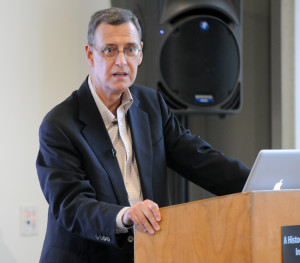Pulitzer Prize-winning journalist Paul Ingrassia spoke to a packed audience Wednesday evening at the Stanford Automotive Innovation Facility on the subject of his new book, “Engines of Change,” which provides “a cultural history that explores how cars have both propelled and reflected the American experience.”
The event was hosted by the Center for Automotive Research at Stanford (CARS) and the Revs Program, and featured Ingrassia, deputy editor in chief of Reuters News, in a casual and humorous discussion. R.B. Brenner, a visiting communication lecturer and fellow Pulitzer Prize winner, moderated the event.

Throughout the discussion, Ingrassia maintained that particular cars in American history have either defined or have served as apt reflections of the cultural zeitgeist. From the Model-T Ford to today’s Toyota Prius, Ingrassia argued that cars tell us a great deal about ourselves and can even influence the way we live and behave.
“Engines of Change” examines 15 quintessentially American vehicles in the context of their time, assessing each on their influence and place in history.
Beginning with the Model-T Ford, Ingrassia described how the manufacturing practices established by Henry Ford created the notion of mass manufacturing and essentially “ended the rural peasantry.”
He continued to describe how the 1920s’ LaSalle, a General Motors creation, was a harbinger of the “roaring ‘20s, a time of increasing wealth when cars meant more than mobility — they meant social mobility.”
Ingrassia reviewed both the Cadillac and the Corvette and discussed the Volkswagen Beetle at length.
“I always find it funny that Hitler’s car became the hippie icon,” he remarked, referring to the Volkswagen’s troubled history.
Initially, the Beetle was sold in America simply to bring hard currency to German automakers’ coffers, but “the combination of breakthrough marketing practices and a steady counter-culture [movement] against excess and conspicuous consumption propelled the car in the American market.”
Ingrassia went on to claim half in jest that the 1960 Chevy Corvair “changed the outcome of the 2000 presidential election.” Ingrassia argued that Ralph Nader’s excoriating book “Unsafe at Any Speed,” which featured the Corvair heavily, contributed to Nader’s popularity and siphoned off votes from Al Gore in the narrowest of recent U.S. presidential elections.
Ingrassia demonstrated links between American history and car design and production, most memorably with a discussion of fins on cars as indicative of the growing influence of marketing and a carefree post-war boom mentality.
“The ‘70s were not a good decade in America,” Ingrassia said. “We had oil shocks, a humiliating loss in Vietnam, Watergate, stagflation. Enter Honda, who, 30 years to this year, opened its first factory in Ohio, marking a watershed moment in American automotive industry, and brought globalization over here.”
Ingrassia subsequently focused on companies’ efforts to tap into different generations of drivers, arguing that certain vehicles arrived at seminal moments that ensured their success and place in automotive industry.
“Chrysler, with its minivans, was able to tap into the baby-boomers when they had grown up, cleaned up, taken a shower, gotten serious, gotten jobs, gotten married and had children,” Ingrassia claimed.
The BMW by contrast defined the notion of luxury for a generation “of yuppies whose whole understanding of luxury had shifted from ornamental and ostentatious to comfort,” a sentiment to which the German manufacturer, according to Ingrassia, obviously appealed.
“Personal journeys and automotive journeys intertwine,” he said. “Think about it. We went from hippie to yuppie and from Beetle to Beamer. That tells you something about us.”
He went on to discuss the influence of the pickup truck as political statement and the Toyota Prius as an environmental one, repeatedly pressing the point that cars are salient representations of culture.
Speaking to The Daily after the event, Ingrassia framed the subject as not “a uniquely American story.”
“There is something distinct about cars here, the wide open roads…but this can be seen all around the world,” he said, recalling observing a similar passion and thrill for cars in India on a recent trip.
With regards to the future of cars, Ingrassia said he sees “autonomous cars as disruptive, in the long term.” He retains the belief, however, that “cars can be practical or they can be for the joy of driving them, which means that different functions will change the way we approach future cars.”
And what does he drive? “A red BMW,” he said with a smile.